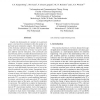Free Online Productivity Tools
i2Speak
i2Symbol
i2OCR
iTex2Img
iWeb2Print
iWeb2Shot
i2Type
iPdf2Split
iPdf2Merge
i2Bopomofo
i2Arabic
i2Style
i2Image
i2PDF
iLatex2Rtf
Sci2ools
CSB
2005
IEEE
2005
IEEE
Relating transcription factors, modules of genes and cultivation conditions in Saccharomyces cerevisiae
Usually, the functionality of a module of co-expressed genes is derived from enrichment within the module of a particular gene annotation category. The systematic setup of the chemostat cultivation experiments employed in this study, where Saccharomyces cerevisiae was grown under four different nutrient limitations, both aerobically and anaerobically, allows us to define the functionality of a module in terms of the module regulation pattern as a function of the growth parameters. In addition, we assign particular transcription factors (TF’s) to each module, thus establishing a direct link between transcription factors and growth conditions. To define a module, the expression data is first discretized employing Lloyd quantization. This process assigns, for each differentially expressed gene in each of the growth conditions, one of three values: upregulated, downregulated or common level. A module is then defined as a group of genes with identical discretized expression patterns ...
Bioinformatics | CSB 2005 | Growth Conditions | Module Regulation Pattern | Particular Gene Annotation |
Related Content
| Added | 24 Jun 2010 |
| Updated | 24 Jun 2010 |
| Type | Conference |
| Year | 2005 |
| Where | CSB |
| Authors | Theo A. Knijnenburg, Marcel J. T. Reinders, J. M. Daran, P. Daran-Lapujade, Lodewyk F. A. Wessels |
Comments (0)

